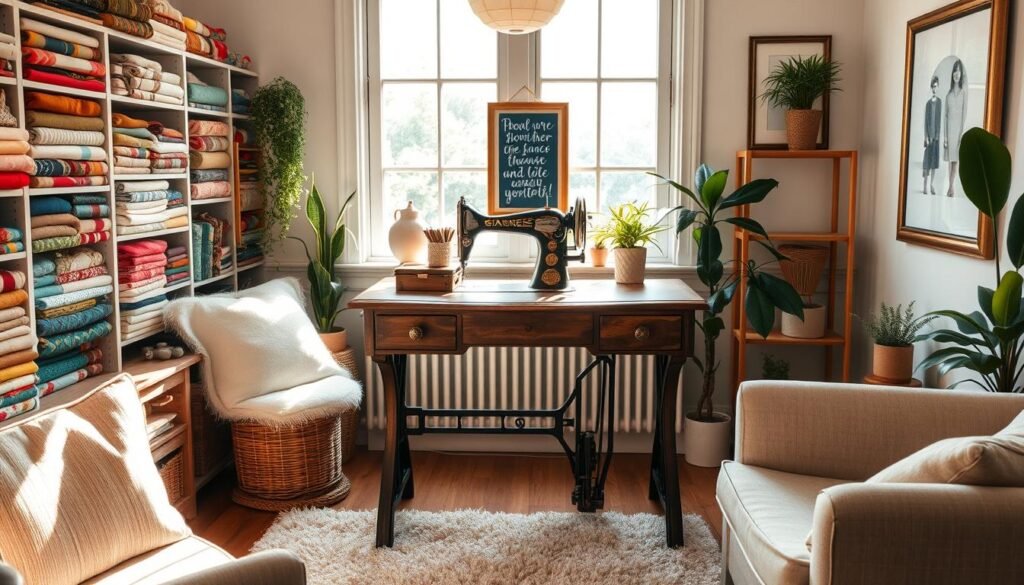Your creative haven deserves more than just basic functionality—it should spark joy and productivity. Whether you’re piecing quilts or designing garments, your workspace becomes a partner in your craft. Let’s explore how thoughtful design choices can transform cluttered corners into inspiration hubs that fuel your best work.
Great spaces balance practicality with personality. Imagine reaching for fabric without digging through piles, or spotting your favorite scissors instantly. The secret? Strategic storage that doubles as decor—think glass jars for colorful threads or vintage crates displaying fabric scraps.
Color plays a starring role too. Warm yellows energize morning stitching sessions, while soft blues keep afternoon focus sharp. We’ll show you how to mix hues that match your creative rhythm.
Best part? You don’t need designer budgets. Repurposed furniture, DIY lighting solutions, and thrifted organizers often work better than pricey alternatives. We’ve tested real setups where $10 shelves outperformed custom cabinetry.
Ready to create a space that works as hard as you do? Let’s build your dream studio—one clever detail at a time.
Choosing Inspiring Color Palettes for Your Creative Space
Your walls do more than hold shelves—they set the mood for every stitch. Light pink and white combos aren’t just pretty; they’re productivity boosters. Designers call this “calm energy”—soft pinks lift spirits while crisp whites keep minds sharp.
Small spaces thrive with airy tones. Try pale blues or mint greens to visually expand your work area. For cozy nooks where you tackle detailed embroidery? Add deep plum or navy accents in throw pillows or rug borders.
Test paint samples at different times of day. Morning light reveals true colors, while evening lamps cast warm glows. One client’s sage walls looked minty at noon but muddy by dusk—she switched to cream instead.
Pro tip: Match your thread organizers and furniture to your palette. A coral storage box pops against gray shelves, creating harmony without monotony. Love bold hues? Use them in removable decor like curtain ties or pin cushions.
Your color theme should feel like your favorite fabric—comforting yet exciting. When walls and tools work together, you’ll spend less time searching for supplies and more time creating magic.
Creative Wall Art Ideas to Elevate Your Sewing Room
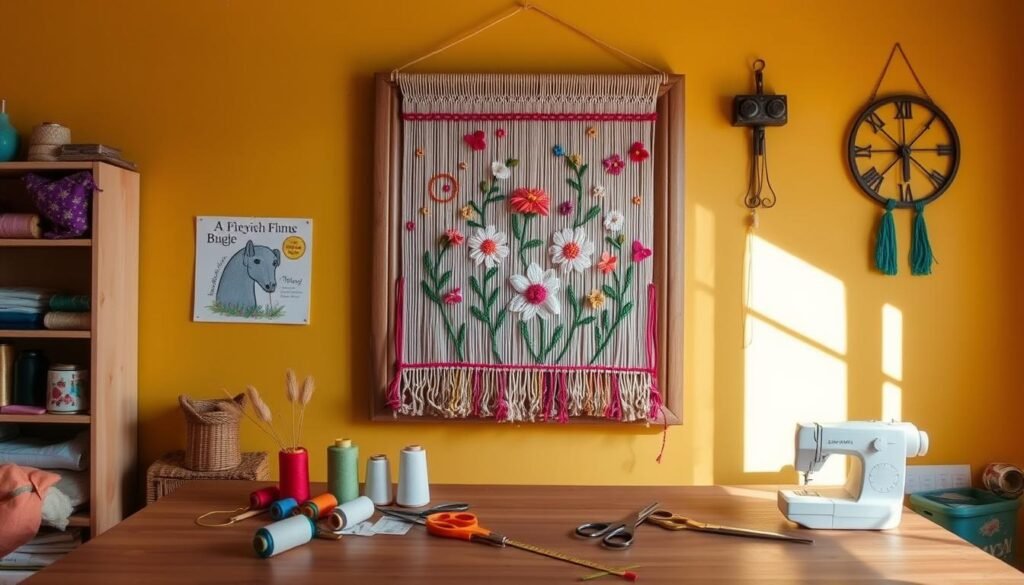
Blank walls become blank canvases in craft spaces. Your vertical surfaces can showcase personality while keeping tools within reach—no more digging through drawers for that specific shade of embroidery floss.
Transform Thread Into Gallery-Worthy Displays
Turn IKEA’s $5 Ribba frame into 3D art that stores 50+ thread bobbins. Remove the glass, glue spools onto cardboard in gradient patterns, and hang your rainbow-organized threads. It’s storage disguised as decoration—perfect for small spaces needing dual-purpose solutions.
Pattern Play That Doesn’t Overwhelm
Mix geometric fabric swatches with organic shapes like vintage button collages. Try this formula: 70% neutral base (white shelves) + 20% bold patterns (chevron pin boards) + 10% whimsy (embroidered “Measure Twice” signs). Balance prevents visual chaos while letting creativity shine.
| Style | Materials Needed | Visual Impact | Time Required |
|---|---|---|---|
| Modern Minimalist | Black frames, monochrome patterns | Clean lines | 1 hour |
| Vintage Charm | Antique patterns, distressed wood | Warm nostalgia | 2-3 hours |
| DIY Functional | Thread spools, empty frames | Interactive display | 90 minutes |
Position statement pieces above your main work area. Floating shelves with framed fabric samples guide eyes upward, making ceilings appear higher. Rotate seasonal pieces—spring pastels in April, rich velvets by December—to keep inspiration fresh.
Pro tip: Add humor with hidden messages. Stencil “This machine fights creative blocks” behind your serger. Only you’ll know it’s there—until guests lean in for a closer look.
Functional Storage Solutions for an Organized Room
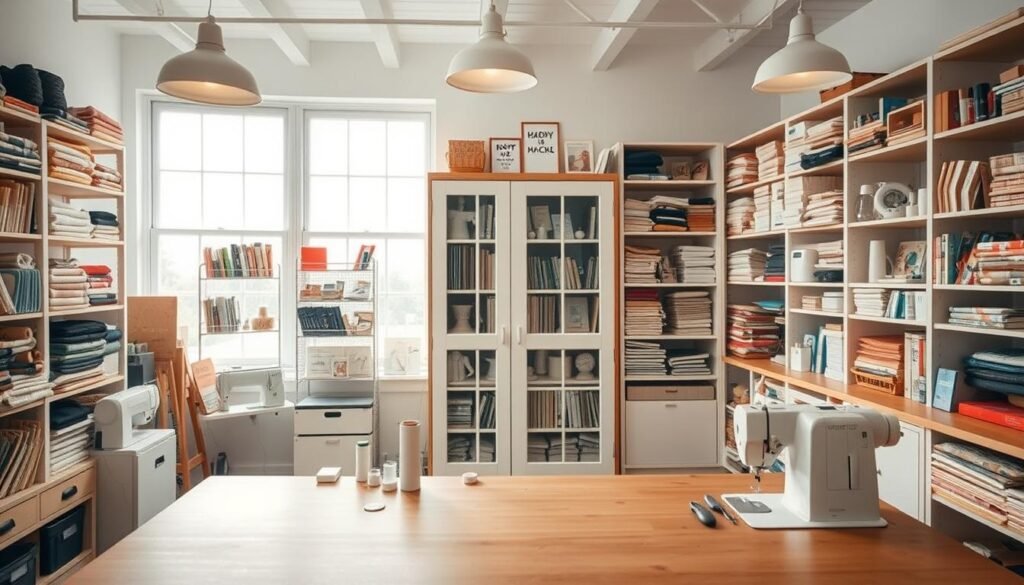
Smart organization transforms cluttered chaos into creative flow. The right storage doesn’t just hide mess—it makes your favorite items part of your studio’s personality.
Pegboards vs. Modular Cabinets
A compact white pegboard works like jewelry for your space. Mount one above your workstation to showcase colorful bobbins and favorite scissors—think gallery wall meets toolbox. Limit tools to 8-10 essentials to maintain a welcoming feel.
Modular cabinets like IKEA’s Kallax shine for hidden needs. Combine doors and drawers to conceal fabric from dust while displaying inspiring pattern books. One crafter stores her metal rulers vertically in narrow cubbies—”Like bookshelves for tools,” she laughs.
Closed storage protects delicate materials best. Sunlight fades vibrant threads over time—keep them in lidded boxes or fabric-lined drawers. For small items, try magnetic tins on metal shelves. They corral pins while adding industrial charm.
Pro tip: Label cubbies with removable chalk stickers. You’ll always find that elusive seam ripper—and guests won’t spot your “emergency chocolate” stash.
Maximizing Small Spaces with Shelves and Tabletop Units
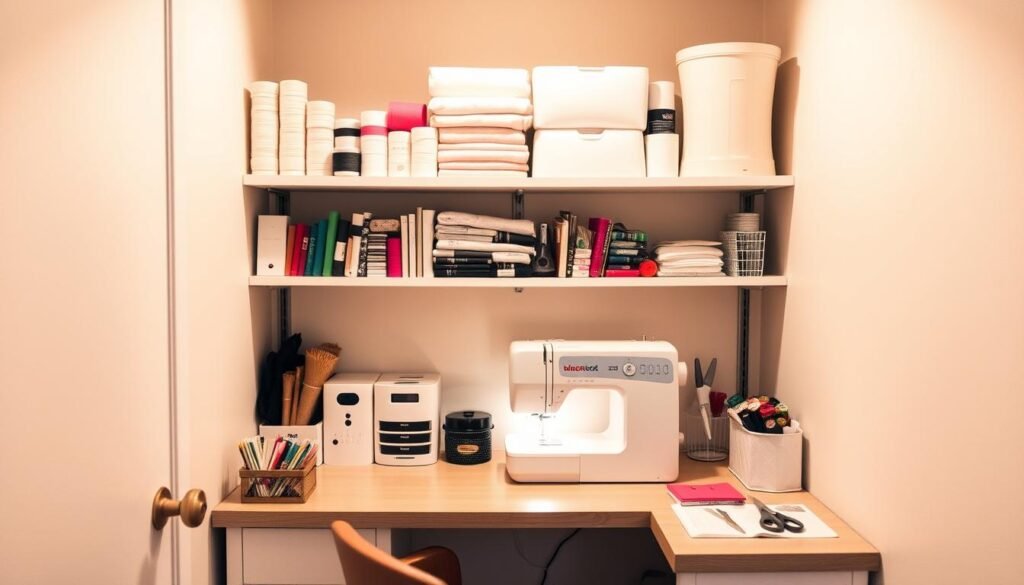
Compact spaces demand clever solutions that work harder than square footage suggests. An IKEA tabletop shelf unit becomes your secret weapon here—its three tiers keep patterns, project books, and daily-use items visible yet tidy. Pair it with matching baskets for supplies that need hiding, like loose buttons or spare zippers.
Corners often gather dust, but they’re prime real estate for floating shelves. Mount them at eye level to store thread cones or measuring tapes, freeing your main work surface. Bonus? High placement draws eyes upward, making ceilings feel taller—a magic trick for cramped areas.
Make sure your storage tools match your style. Neutral baskets blend into minimalist spaces, while vibrant containers add pops of color. One creator uses mint-green bins to complement her floral wallpaper—functional storage that enhances her theme.
For bulky tools like cutting mats, try vertical slots between shelves or wall-mounted clips. Folded patterns thrive in hanging file pockets behind doors. Smart systems like these let you grab essentials mid-project without breaking creative flow.
Truth bomb: A 6×6 foot nook with intentional organization often outperforms a 12×12 room drowning in clutter. Your space isn’t small—it’s just waiting for the right strategy.
Personalizing Your Workspace with Unique Accessories
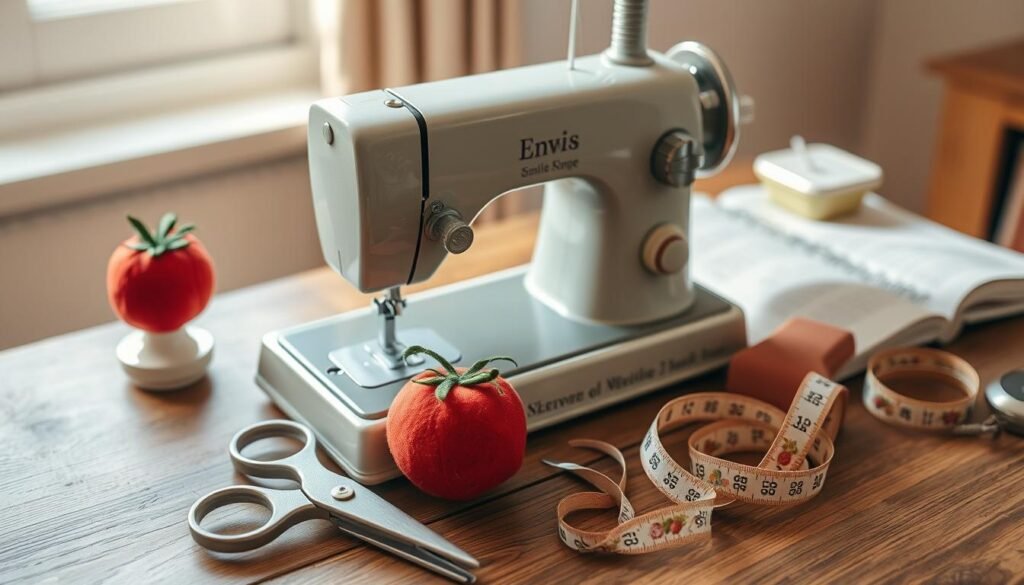
Your creative zone becomes truly yours when you infuse it with pieces that tell your story. These finishing touches turn ordinary tools into conversation starters while keeping essentials at your fingertips.
Miniature Marvels That Multitask
That vintage-style jewelry case shaped like a sewing machine? It’s more than cute decor. The rhinestone-studded drawers hold needle threaders and metal thimbles, while the spool-shaped compartment keeps safety pins organized. Display it open to show off colorful thread spools inside.
Storage That Sparks Joy
Stackable bobbin rings solve two problems at once. Their rainbow hues brighten your workspace while preventing tangled messes. Pair them with metal wall hooks shaped like scissors—perfect for hanging measuring tapes or ribbon scraps.
Vintage “Mend & Make Do” signs add character without clutter. Lean one against your machine or mount it above floating shelves. For functional flair, arrange decorative pins in shadow boxes—they’ll keep loose needles handy while creating wall art.
Remember: Your favorite tools deserve to be seen. A grandmother’s thimble collection becomes heritage decor in glass cloches. Those novelty scissors from your gift exchange? Hang them on decorative knobs. When every piece has purpose and personality, inspiration strikes faster.
Lighting Ideas to Enhance Your Creative Environment
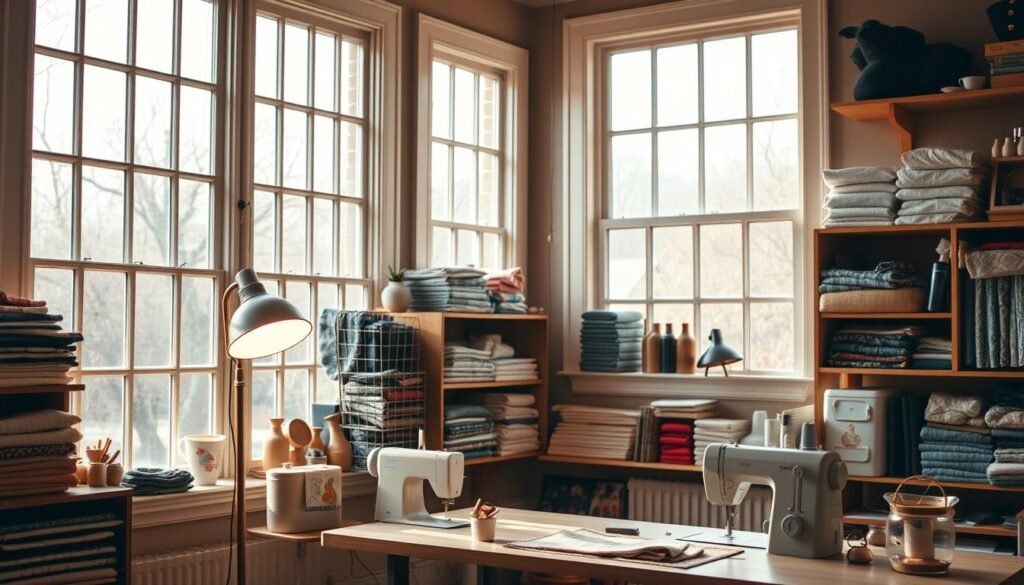
The right lighting transforms more than your workspace—it reshapes your creative process. Natural glow and artificial beams work together to reduce eye fatigue while making colors pop accurately. Let’s illuminate solutions that adapt to your rhythm.
Natural Light vs. Ambient LED Options
Morning stitchers: Position your machine near east-facing windows. Sheer lace panels diffuse harsh sunlight while keeping your space private. For afternoon sessions, add sliding mirror panels—they bounce light deeper into corners and let you check garment fits instantly.
LED strips under shelves solve two problems. They cast shadow-free light on intricate work and use 75% less energy than bulbs. Choose adjustable color temperatures: cool white for matching threads, warm tones for evening comfort. One creator uses smart bulbs programmed to shift hues with the sun—”Like having sunset in a jar,” she says.
Strategic mirror placement doubles brightness without extra fixtures. Try a full-length version behind your chair to reflect overhead lights. Bonus: Your design wall gets indirect illumination, showing fabric textures better.
Color accuracy matters most when picking materials. Test swatches under both natural and LED sources—that perfect teal might look turquoise at night. Budget hack? Clip-on LED magnifiers attach to tables, giving salon-quality light for $15.
The Impact of Mirrors on Your Sewing Room Decor
Mirrors work magic beyond checking hemlines—they’re secret weapons for transforming cramped areas into airy studios. Strategic placement turns reflective surfaces into light amplifiers and space expanders, proving functionality and flair can coexist.
Size Matters More Than You Think
Sliding mirrored doors solve two problems at once. They create instant fitting stations while hiding fabric stashes behind their glossy surfaces. For detailed work, a 12×18″ mirror with a blush frame lets you verify seam allowances without leaving your chair.
Taller ceilings demand vertical solutions. Floor-length mirrors draw eyes upward, making compact areas feel grand. Try leaning one against your main wall—it becomes movable art that bounces light across your workstation during golden hour.
Placement makes or breaks the effect. Position mirrors opposite windows to flood your space with natural glow. Avoid reflecting cluttered corners—angle them toward your prettiest storage solutions or color-coordinated thread displays instead.
Pro tip: Match frames to your existing hardware. Brass-edged mirrors echo vintage scissors holders, while black matte borders complement modern machines. One creator swapped her basic bathroom mirror for an ornate gold version—”Now my studio feels like a Parisian atelier,” she beams.
Mirrored cabinets offer sneaky storage with style. Use them to conceal pins and bobbins while maintaining that open, luminous feel. Your space stays organized without sacrificing an inch of visual breathing room.
Modern Sewing Room Decor Trends for Today’s Creative Spaces
Today’s creative spaces blend form and function like never before. Imagine work zones where sleek surfaces meet smart tech—where every inch serves your craft and your aesthetic vision. We’re seeing spaces evolve into hybrid studios that adapt as quickly as your latest project demands.
Essential Elements in a Functional Craft Room
Start with ergonomics—your body will thank you during marathon sessions. Adjustable-height tables paired with lumbar-support chairs prevent fatigue. Proper ventilation matters too—try whisper-quiet air purifiers that double as plant stands.
Lighting should multitask. Combine overhead LEDs with dimmable task lamps that adjust to your project’s needs. Charging stations built into drawers keep devices powered without cluttering surfaces.
Hidden Storage Innovations and Display Techniques
Magnetic panels disguised as framed art hold metal rulers and scissors. Behind that floating shelf? A pull-out ribbon organizer with 24 spool slots. Modern solutions hide clutter while celebrating your tools as decor.
| Solution | Space Saved | Installation Time | Budget Level |
|---|---|---|---|
| Fold-down ironing board | 5 sq ft | 45 minutes | $$ |
| Rotating thread tower | 2.5 sq ft | 30 minutes | $ |
| Under-table fabric bins | 8 sq ft | 15 minutes | $ |
Display your favorite items using acrylic risers—they turn button jars into museum exhibits. Glass-front cabinets protect delicate fabrics while letting color palettes inspire. The key? Keep often-used items at arm’s reach, archive others behind closed doors.
Tech integration happens subtly now. Wireless charging pads hide under linen drawer liners. Tablet stands clip to adjustable arms—watch tutorials while stitching. Your space stays timeless, even as trends shift.
DIY Projects for a Personal Craft Corner
Transform blank walls into dynamic inspiration boards with projects that reflect your creative fingerprint. These hands-on solutions marry utility with self-expression—perfect for makers who want their space to evolve alongside their skills.
3D Wall Art That Works Harder
Turn embroidery hoops into floating shelves for spools or fabric swatches. Stretch lace remnants across smaller hoops—add vintage buttons at intersections for tactile texture. Mount them in clusters that mimic quilt patterns for instant depth.
Upcycle wooden crates into modular displays. Paint interiors in gradient hues, then stack horizontally to house ribbon rolls or pattern books. Leave one compartment open for quick-access tools like metal measuring tapes—functional art that adapts daily.
For bold statements, layer laser-cut plywood shapes over painted canvases. Geometric hexagons hold pins along their edges, while circular cutouts cradle thread cones. It’s gallery-worthy storage that turns basic supplies into design features.
Pro tip: Use shadow boxes to showcase textured materials. Arrange velvet scraps, pearl buttons, and silk ribbons in dimensional collages. Rotate elements seasonally to keep your creative spark ignited.
Your walls can do more than hold tools—they can tell your creative story. Start with one focal piece, then build outward as inspiration strikes. Before you know it, you’ll have a living mood board that grows with every project.

